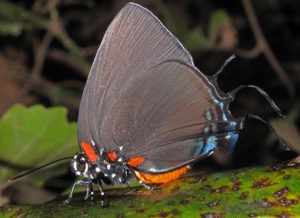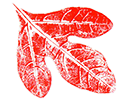Looking out my front window, I can see an old walnut tree with a couple of clumps of mistletoe in it. As I look at the mistletoe clumps in the walnut tree, I can’t help but wonder if the walnut tree is providing a winter home to any Great Purple Hairstreak chrysalises.
The Great Purple Hairstreak (Atlides halesus) is a medium sized butterfly. Its wingspan is between 1.25 and 2 inches wide or slightly less than the length of most people’s thumb. The Great Purple Hairstreak can be found throughout the southern U.S. with some populations being found as far south as Guatemala and as far north as Maryland. It is most common below the 38th parallel.

Despite its name, there is very little to no purple on the Great Purple Hairstreak. When the wings are closed and the sun hits them just right, they have a faint hint of a light purple. The primary colors that are most evident are black, iridescent blue, and orange. The Great Purple Hairstreak perches with its wings closed so most of the time you only get glimpses or the bright, iridescent blue found on the upper surface of the wings.
Male Great Purple Hairstreaks perch at the top of trees and move their wings to attract females. The flashes of blue probably help in getting the female’s attention. Once a male has attracted a female, they’ll mate and the female will lay her eggs on the leaves of mistletoe. Mistletoe is a native, semi-parasitic bush that grows in a variety of tree species.
When the eggs hatch, the caterpillars will feed on the mistletoe leaves. The caterpillars are green and blend in well with the leaves. Great Purple Hairstreak caterpillars are the only caterpillars that feed on mistletoe and mistletoe is the only plant that the caterpillars can eat. They need mistletoe in the same way that monarchs need milkweed.
The caterpillars will crawl off the mistletoe and either into a crevice in the tree’s bark or at the base of the tree when it is time to form a chrysalis, pupate, and turn into a butterfly. The adult butterflies only live for approximately 24 days. During that time, the adult butterflies will feed on the nectar of many different species of flowers including goldenrods, climbing hempweed, devil’s walking stick, ragwort, mistflower, and many others. While drinking the nectar from the flowers, the butterflies transfer pollen between the flowers and serve as pollinators. The adults are active from March until November. The Great Purple Hairstreaks may go through up to three generations in a single year.
Great Purple Hairstreaks may not be as well recognized or well-known as some other butterfly species. However, they are still a very beautiful and interesting Kentucky pollinator that has a unique relationship with an important native plant.

This article was part of Shannon’s original Kentucky Pollinators and Backyard Wildlife blog which evolved into the blog for Backyard Ecology.

Backyard Ecology: Exploring Nature in Your Backyard
Nature isn’t just “out there.” It’s all around us, including right outside our doors. Hi, my name is Shannon Trimboli, and I am the host of Backyard Ecology. I live in southcentral Kentucky and am a wildlife biologist, educator, author, beekeeper, and owner of a nursery specializing in plants for pollinators and wildlife conservation. I invite you to join me as we ignite our curiosity and natural wonder, explore our yards and communities, and improve our local pollinator and wildlife habitat. Learn more or subscribe to my email list at www.backyardecology.net.

Leave a Reply